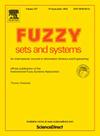亚里士多德用来挖掘模糊概念的方阵
IF 3.2
1区 数学
Q2 COMPUTER SCIENCE, THEORY & METHODS
引用次数: 0
摘要
亚里士多德方形,也被称为对位方形,是一个可以追溯到希腊哲学的数学图表,以简单的图形形式展示了四个逻辑命题之间的联系。模糊关系概念分析(FRCA)是一种从模糊关系上下文族(FRCF)中提取称为模糊概念的特殊聚类的技术,FRCF是由多个模糊对象-属性和对象-对象关系组织的数据集。从数据中获取信息的主要FRCA工具是特殊的模糊量词,它们被视为中间广义量词形式理论公式模型中的解释。这项工作的重点是通过选择四个特定FRCA量词中的一个,从某个FRCF中生成模糊概念集合的问题:正全称量词S1、负全称量词S1−、正存在量词S∃和负存在量词S∃−。当然,量词的选择在FRCA程序中是至关重要的,因为它影响到最终的概念分类:不同的量词产生不同的模糊概念。作为最初的目标,本文引入了涉及S1,S1−,S∃和S∃−的逻辑关系,以便将它们排列在亚里士多德平方的分级版本中。本研究的第二个目标是检查{S1,S1−,S∃,S∃−}中由不同量词产生的模糊概念之间的联系。因此,我们的发现为亚里士多德方形的进步提供了双重贡献。事实上,他们在模糊关系概念分析的框架内揭示了对对方阵的一种新的解释,强调了它作为数据分析的有价值工具的潜力。本文章由计算机程序翻译,如有差异,请以英文原文为准。
Aristotle's square for mining fuzzy concepts
Aristotle's Square also known as Square of Opposition, is a mathematical diagram dating back to Greek philosophy and exhibiting the connection between four logical propositions in a simple graphical form. Fuzzy Relational Concept Analysis (FRCA) is a technique for extracting special clusters called fuzzy concepts from a Fuzzy Relational Context Family (FRCF), which is a dataset organized as multiple fuzzy object-attribute and object-object relations. The primary FRCA tools to obtain information from data are special fuzzy quantifiers viewed as interpretations in a model of formulas of the formal theory of the intermediate generalized quantifiers. This work focuses on the issue of generating a collection of fuzzy concepts from a certain FRCF, by choosing one of four particular FRCA quantifiers: the positive universal quantifier , the negative universal quantifier , the positive existential quantifier , and the negative existential quantifier . Certainly, the selection of the quantifier is crucial in the FRCA procedure since it affects the final concept classification: diverse fuzzy concepts arise from varying quantifiers. As the initial objective, this article introduces the logical relations involving , , and , in order to arrange them in a graded version of the Aristotelian square. The second goal of this study is to examine the connections among fuzzy concepts produced by distinct quantifiers in . Therefore, our findings provide a twofold contribution to the advancement of Aristotle's square. Indeed, they reveal a novel interpretation of the square of opposition within the framework of Fuzzy Relational Concept Analysis, emphasizing its potential as a valuable tool for the analysis of data.
求助全文
通过发布文献求助,成功后即可免费获取论文全文。
去求助
来源期刊

Fuzzy Sets and Systems
数学-计算机:理论方法
CiteScore
6.50
自引率
17.90%
发文量
321
审稿时长
6.1 months
期刊介绍:
Since its launching in 1978, the journal Fuzzy Sets and Systems has been devoted to the international advancement of the theory and application of fuzzy sets and systems. The theory of fuzzy sets now encompasses a well organized corpus of basic notions including (and not restricted to) aggregation operations, a generalized theory of relations, specific measures of information content, a calculus of fuzzy numbers. Fuzzy sets are also the cornerstone of a non-additive uncertainty theory, namely possibility theory, and of a versatile tool for both linguistic and numerical modeling: fuzzy rule-based systems. Numerous works now combine fuzzy concepts with other scientific disciplines as well as modern technologies.
In mathematics fuzzy sets have triggered new research topics in connection with category theory, topology, algebra, analysis. Fuzzy sets are also part of a recent trend in the study of generalized measures and integrals, and are combined with statistical methods. Furthermore, fuzzy sets have strong logical underpinnings in the tradition of many-valued logics.
 求助内容:
求助内容: 应助结果提醒方式:
应助结果提醒方式:


